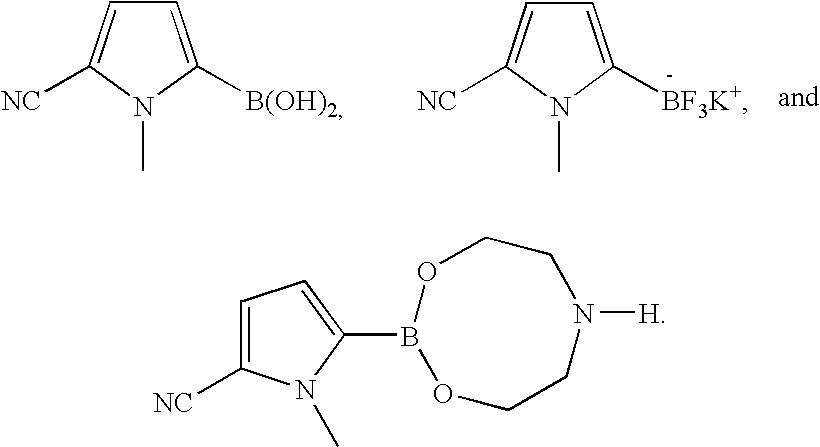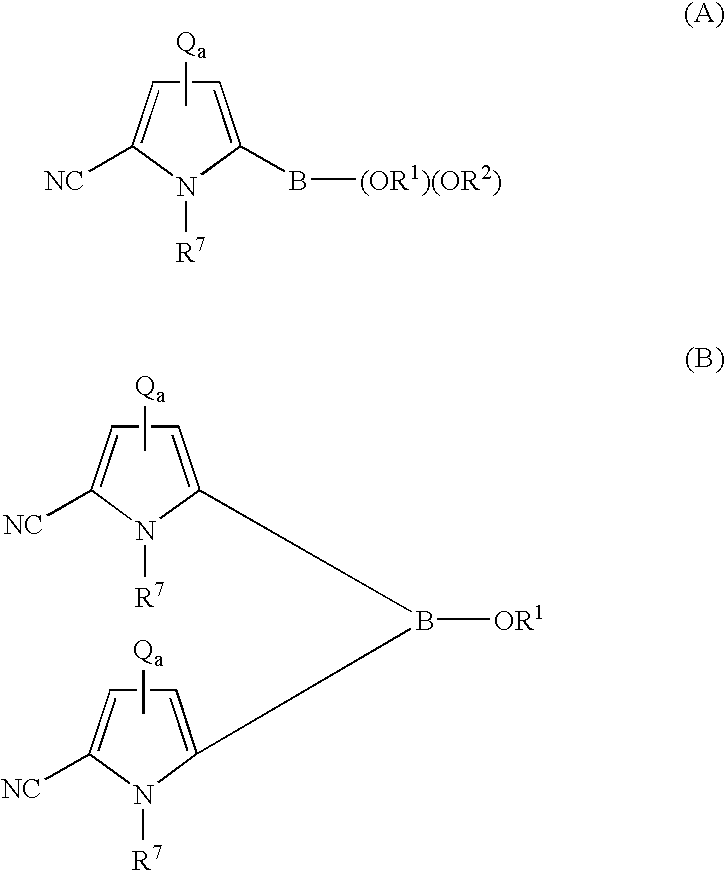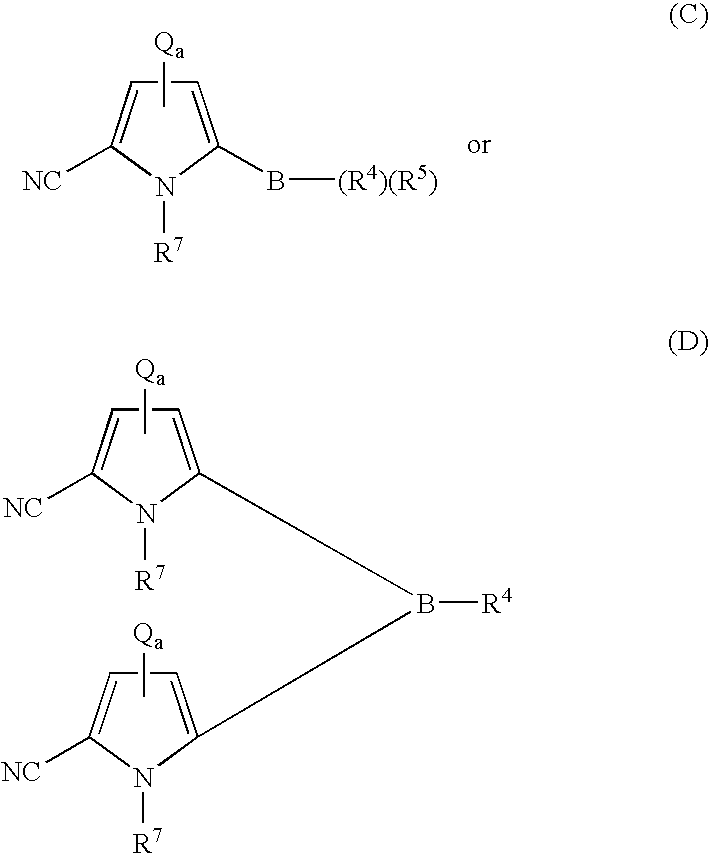Coupling process for generating reactive boron-containing derivatives of N-substituted pyrrole-2-carbonitriles to produce biaryls
- Summary
- Abstract
- Description
- Claims
- Application Information
AI Technical Summary
Problems solved by technology
Method used
Image
Examples
example 1
Preparation of the Boron Containing Compounds
A. The Boronate Mixture
[0106] To a 3-L flask equipped with nitrogen inlet, pump inlet, overhead stirrer, temperature controller and a cooling bath were charged 1-methylpyrrole-2-carbonitrile (99 g, 0.933 mol), triisopropylborate (176 g, 216 mL, 0.936 mol), and THF (600 mL). After cooling the solution to about 0° C., 2M LDA (606 mL, 1.21 mol) was added in small portions, via a pump, at the rate of about 2.5 mL / min. The bath was removed and the suspension was stirred for about 1 hour at about 15° C.
B. The Trifluoroborate Salt
[0107] The boronate mixture (16 mL) prepared as described above was stirred with 5M aqueous sodium hydroxide (NaOH; 15 mL) for about 30 minutes then acidified with 10% aqueous hydrochloric acid (HCl) to a pH of about 2. Extraction with ethyl acetate and evaporation to dryness left a residue that was dissolved in methanol (MeOH; 5 mL) and treated with potassium hydrogen fluoride (KHF2; 0.77 g) in water (10 mL). Aft...
example 2
SCALE-UP PREPARATION OF 5-[1,3,6,2]DIOXAZABOROCAN-2-YL-1-METHYL-1H-PYRROLE-2-CARBONITRILE
[0110] In this example, a larger scale production of 5-[1,3,6,2]dioxazaborocan-2-yl-1-methyl-1H-pyrrole-2-carbonitrile was performed using the procedure of Example 1D. 1-Methylpyrrole-2-carbonitrile (6.01 kg, 56.6 mol) and triisopropyl borate (10.7 kg, 56.9 mol) were dissolved in tetrahydrofuran (48 kg). The solution was transferred into a reactor containing pre-cooled to −2° C. 2.0 M lithium diisopropylamide in heptane, ethylbenzene and THF (39.3 kg, 96.8 mol). The addition was performed over 3 hours and the reaction temperature was controlled in the range of −5 to 5° C. Following a hold of at least 30 minutes at 0 to 10° C., the batch was sampled for reaction completion analysis by high performance liquid chromatography (HPLC). Residual starting material was analyzed at 0.28%.
[0111] The reaction mixture was quenched with 4N HCl (65 kg) between 0 and 15° C. To achieve good phase separation, 1...
example 3
Coupling Using the Boronate Salt Mixture
[0112] A 5-L, 4-necked flask equipped with nitrogen inlet, overhead stirrer, reflux condenser, pump inlet and temperature controller was charged with THF (600 mL), the Brofoxine™ reagent (128 g, 0.500 mol), solution of potassium carbonate (132 g, 0.955 mol) in water (460 mL), and tetrakis(triphenylphosphine)palladium (1.2 g, 0.001 mol). The suspension was heated to about 65° C. and the boronate mixture of Example 1 was added in small portions at a rate of about 5 mL / min. The reaction mixture was cooled to about 10° C. and treated, in small portions, with concentrated HCl (300 mL) to a pH of about 4 to about 5. Water (1.0 L) was added and the phases were separated. The organic phase was diluted with THF (300 mL). The Darco® KB clearing aid (12.0 g) was added and the mixture was filtered through a pad of the Celite® reagent. After washing the cake with THF (300 mL), the filtrate was distilled under vacuum to about one-fourth of the original vol...
PUM
 Login to View More
Login to View More Abstract
Description
Claims
Application Information
 Login to View More
Login to View More - R&D
- Intellectual Property
- Life Sciences
- Materials
- Tech Scout
- Unparalleled Data Quality
- Higher Quality Content
- 60% Fewer Hallucinations
Browse by: Latest US Patents, China's latest patents, Technical Efficacy Thesaurus, Application Domain, Technology Topic, Popular Technical Reports.
© 2025 PatSnap. All rights reserved.Legal|Privacy policy|Modern Slavery Act Transparency Statement|Sitemap|About US| Contact US: help@patsnap.com



